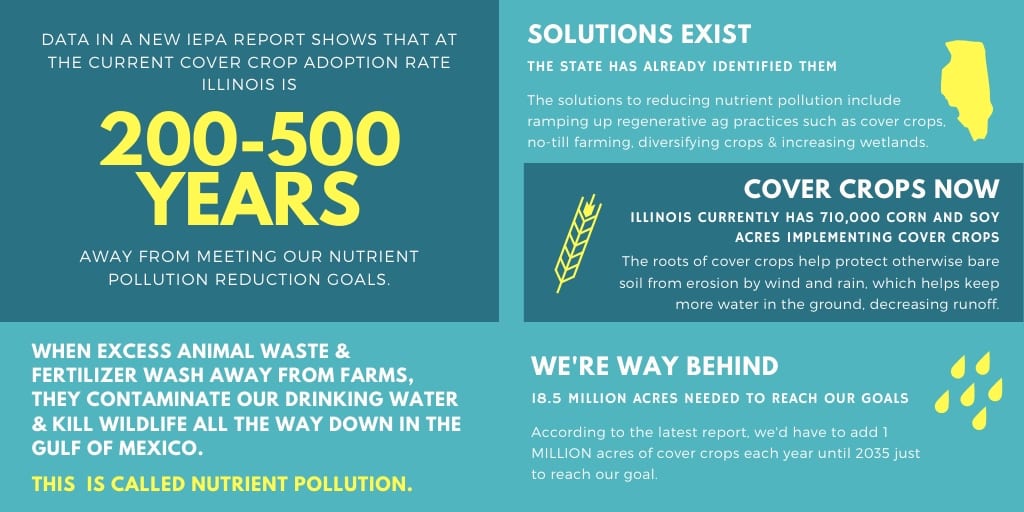FOR IMMEDIATE RELEASE
Nov. 18, 2019
ILLINOIS OVER 200 YEARS FROM REACHING NUTRIENT POLLUTION REDUCTION GOALS
Conservation and Sustainable Agriculture Groups Respond
to IEPA Agriculture Pollution Report
Contacts:
Tucker Barry, tucker@ilenviro.org, 337-280-1269
Jeff Kohmstedt, jkohmstedt@prairierivers.org, 217-344-2371 x 207
Piero Taico, piero@ilstewards.org 312-505-9922
SPRINGFIELD, IL — Conservation and sustainable agriculture organizations working to reduce nutrient pollution in Illinois waterways have issued the following joint statement in response to the release of the Illinois Nutrient Loss Reduction Strategy (NLRS) Biennial Report by the Illinois Environmental Protection Agency (IEPA) and the Illinois Department of Agriculture (IDOA):
“This report confirms long-held concerns that soil erosion and harmful pollution associated with agriculture is continuing at an alarming rate. Nitrates and phosphorus are increasing–the opposite of the direction we should be moving–and the consequences are serious both here in Illinois, down the Mississippi River, and across the world.
“We are seeing thousands of new cover crop acres added per year. To meet our 2035 goals we need over a million new acres of cover crops every year. At the current rate of adoption, Illinois will not reach our nutrient pollution reduction goals for over 200 years.¹
“One practice alone will not solve the nutrient loss issue. A combination of infield practices (cover crops, conservation tillage, nutrient management, etc.) and edge-of-field practices need to be adopted at a faster rate. In areas with tile drainage, constructed wetlands, bioreactors, and saturated buffers need to be implemented to capture and remove nitrates before they leave the field and enter downstream waters.
“The NLRS relies on voluntary adoption of conservation practices like cover crops, but this report points to another alarming observation–that public funding for educational outreach programs aimed at expanding the use of cover crops had decreased over the last few years, setting us far behind our nutrient pollution goals. To reach our goals, Illinois will need to increase its support for farmers to incorporate conservation into their farms.
“With so far to go, there are many solutions on the table to help us ramp up our nutrient pollution reduction, but we all agree that a comprehensive climate adaptation plan will help meet nutrient loss reduction goals, face increasingly uncertain weather, protect drinking water and farmers’ bottom lines, secure our food supply and rehabilitate the ecosystem in the Gulf of Mexico.”
The organizations releasing this statement today include:
Illinois Environmental Council, Delta Institute, Illinois Stewardship Alliance, Izaak Walton League of America, The Wetlands Initiative and Prairie Rivers Network.
BACKGROUND INFORMATION
The Illinois Nutrient Loss Reduction Strategy lays out a plan to leverage existing programs to optimize nutrient loss reduction while promoting collaboration, research, and innovation among the private sector, academia, non-profits, wastewater treatment agencies, the agricultural sector, and state and local government. The primary strategy goals are to reduce annual loading of nitrate-nitrogen and total phosphorus to the Mississippi River and address the impacts of local water quality. The ultimate goal is to achieve 45 percent loss reductions in both nitrate-nitrogen and total phosphorus, with the interim loss reduction goals of 15 percent in nitrate-nitrogen and 25 percent total phosphorus by 2025.
This Biennial Report on the Illinois Nutrient Loss Reduction Strategy describes actions taken to achieve the goals since the document’s release. Reflecting the strategy, efforts have been focused in three sectors that can play significant roles: agriculture, point source, and urban stormwater.

###
¹Calculated using the Census of Agriculture’s 2012 and 2017 data.







